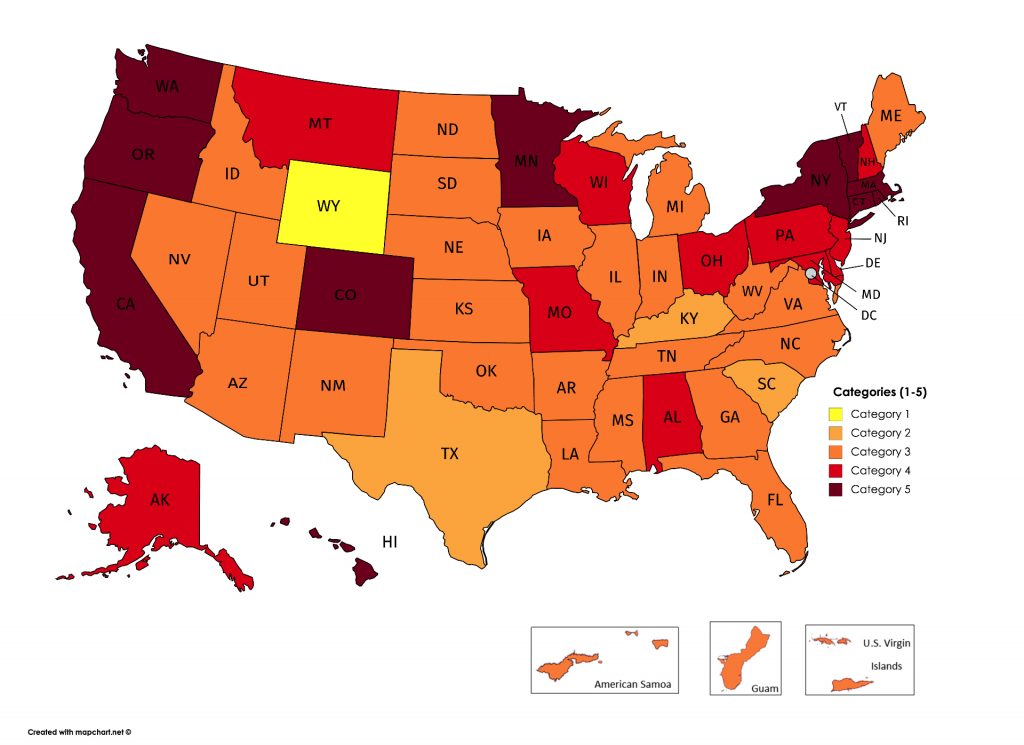By Dena Adler
A newly released Sabin Center White Paper, “State Hazard Mitigation Plans & Climate Change: Rating the States 2019 Update,” reviews how well the states have integrated climate change into their State Hazard Mitigation Plans (SHMPs). SHMPs serve as “blueprints” for state efforts to prepare for natural and man-made hazards and must include consideration of changing future climate conditions based on 2016 guidance from the Federal Emergency Management Agency (FEMA). States must submit SHMPs to FEMA and update them every five years to remain eligible to receive certain types of non-emergency disaster assistance, including funding for mitigation projects.
Key Report Findings Include:
- The Majority of States Now Recognize Climate Change Explicitly in Their SHMPS: In the 2019 SHMP Report, 49/53 states and territories achieved a category 3 or higher ranking, which means they explicitly recognize and discuss climate change in their plans. (See Figure 1’s caption for description of category ranking system.)
Figure 1: Map of State Hazard Mitigation Plan (SHMP) Climate Change Ranking

- The Majority of States Significantly Improved Their Discussion of Climate Change in Their SHMPs: Among the 50 states reviewed in both analyses, 39 states improved their consideration of climate change significantly enough to move up the rankings by at least one category. Of the states that moved up the rankings, 18 state plans moved up 1 category, another 17 state plans moved up 2 categories, and 4 state plans moved up 3 categories. Even some states that did not advance to a higher category issued new SHMPs that showed improved consideration of climate change as compared to their previous reports. No states moved down in the rankings.
- A Few States Still Do Not Recognize Climate Change in Their SHMPs: Two states still do not use the term “climate change” in their plans: Kentucky (2018) and Texas (2018). Even though states may use other terminology such as “changing conditions” or describe worsening hazard risks without making the explicit link to climate change, it prevents optimal planning to sidestep explicit recognition of the underlying phenomenon which is causing a change in risk levels. Notably, these two plans were both released after the FEMA Climate Guidance went into effect. Four states ranked as a category 2 or lower with either no or minimal mention of climate change and its impacts (Kentucky, South Carolina, Texas, and Wyoming).
- Leading States Improved Upon Their Record for Integrating Climate Change into Their SHMPs: A new category 5 was created in the ranking system to recognize eleven states that had improved their coverage of climate risks, integration of their climate response across different state bodies, and proposals for adaptation actions significantly beyond the baseline category 4 criteria from the 2013 SHMP Report.
- Improvement Among Landlocked States: Many landlocked states improved their rankings by acknowledging climate change and its related hazards, contrasting with the 2013 SHMP Report’s observation that many landlocked states ranked as category 1.
For more information on how well states read the executive summary and full report here.

